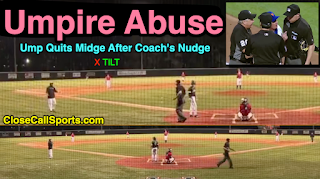In the 17th inning of Evansville and Vanderbilt's marathon game, Vandy baserunner R1 Davis Diaz tried to steal second base on a pitch ultimately fouled at the plate, but instead of returning to first base as foul balls generally prescribe, Diaz stayed at second with an umpire standing mere feet away. Was this a legal stolen base or did the fatigue of a 17 inning game factor into a misappropriated 90 feet for the home team?
The answer begins with the definition of a foul ball: "The ball becomes dead and runners advance one base, or return to their bases, without liability to be put out, when…a foul ball is not caught, in which case runners return to their bases" (Official Baseball Rule 5.06(c)(5)), or, because this was a college game, the relevant rule of NCAA 6-2-a: "The ball becomes dead and base runners return when…A foul is hit that is not caught. Runners return and the umpire shall not put the ball in play until all runners have retouched their bases."
No matter the level or how you phrase it, the theme is consistent: foul ball, runners return, right?
Well, there's a little more to it than meets the eye. Replays indicate that baserunner R1 Diaz arrived at and passed second base before Evansville pitcher Nate Hardman begin his motion, of out Set Position, toward home plate. This means that Diaz's advancement to second base was legal despite (ruled defensive indifference with the winning run on third base) the ensuing foul ball because he had already arrived at and occupied second base prior to the pitching motion to home plate: on foul balls, runners are to return to bases occupied at time of pitch.
As for the definition of when, exactly, a pitcher's actions constitute the exact time of pitch, NCAA 2-82 states, "The time of the pitch is (1) in the wind up position, when the pitcher makes any movement habitually connected with the delivery to the plate, or (2) in the set position, when the pitcher begins the natural movement associated with the pitcher's delivery of the ball after the pitcher has come set with both hands together in front of their body."
Accordingly, the runner R1 Diaz successfully advances to second base prior to time of pitch, and thus becomes R2 prior to the foul ball sequence; this means when he returns to his original base at time of pitch, he is returning to second base and not first base.
Video as follows:















